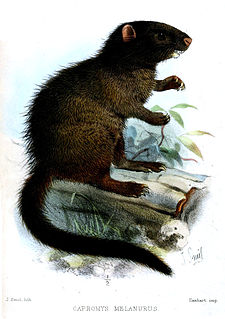
Solenodons are venomous, nocturnal, burrowing, insectivorous mammals belonging to the family Solenodontidae. The two living solenodon species are the Cuban solenodon, and the Hispaniolan solenodon. Threats to both species include habitat destruction and predation by non-native cats, dogs, and mongooses, introduced by humans to the solenodons' home islands to control snakes and rodents.

The Puerto Rican nesophontes, or Puerto Rican shrew, is an extinct eulipotyphlan endemic to Puerto Rico.

Nesophontes, sometimes called West Indies shrews, is the sole genus of the extinct, monotypic mammal family Nesophontidae in the order Eulipotyphla. These animals were small insectivores, about 5 to 15 cm long, with a long slender snout and head and a long tail. They were endemic to the Greater Antilles, in Cuba, Hispaniola, Puerto Rico, the United States Virgin Islands, and the Cayman Islands.

The black-tailed hutia(Mysateles melanurus), also known as the bushy-tailed hutia, is a species of rodent in the subfamily Capromyinae that is endemic to lowland moist forests in Cuba. It is threatened by habitat loss.

The prehensile-tailed hutia is a species of hutia in the subfamily Capromyinae endemic to Cuba. It is an arboreal foliovore, found in both primary and secondary forest.
The Atalaye nesophontes is an extinct species of mammal in the family Nesophontidae. It was endemic to Hispaniola in the Caribbean, and is only known from fossil deposits.
The St. Michel nesophontes is an extinct species of mammal in the family Nesophontidae. It was endemic to Hispaniola.
The Haitian nesophontes is an extinct species of mammal in the family Nesophontidae. It was endemic to Hispaniola in the Caribbean.
The Caribbean bioregion is a biogeographic region that includes the islands of the Caribbean Sea and nearby Atlantic islands, which share a fauna, flora and mycobiota distinct from surrounding bioregions.

The greater Cuban nesophontes is an extinct species of eulipotyphlan that was native to Cuba. It is thought that the introduction of rats lead to its demise.
A unique and diverse albeit phylogenetically restricted mammal fauna is known from the Caribbean region. The region—specifically, all islands in the Caribbean Sea and the Bahamas, Turks and Caicos Islands, and Barbados, which are not in the Caribbean Sea but biogeographically belong to the same Caribbean bioregion—has been home to several families found nowhere else, but much of this diversity is now extinct.
The Cuban evening bat is a species of bat in the vesper bat family, Vespertilionidae, that is endemic to western Cuba. It is a small bat, even smaller than cogener Nycticeius humeralis. It is insectivorous, but otherwise little is known about its behavior and diet.
The Cuban yellow bat is a species of bat from the family Vespertilioninae. It was previously included as a subspecies of the northern yellow bat, a species that has a similar ecology and biology. The species is endemic to Cuba, specifically the Las Villas Province in Cienfuegos, and it is listed under the IUCN Red List as vulnerable due to its ongoing population reduction and relatively small geographic range.
Pfeiffer's red bat is a species of bat from the family Vespertilioninae and is endemic to Cuba. It is listed as Near Threatened by the IUCN Red List due to a significant population decline, caused by human population density on its endemic island, habitat conversion, and hurricanes. The species is likely insectivorous; fecal matter samples from a single bat contained only beetles. It may be a subspecies of the Seminole bat.
The Cayman nesophontes is an extinct eulipotyphlan of the genus Nesophontes that was once endemic to the Cayman Islands ; the shrew lived in the island montane forest/brush endemic to the Cayman Islands and was an insectivore. It is known from subfossil remains, that bear bite marks attributed to crocodiles, collected from caves, sinkholes and peat deposits on the Islands between the 1930s and the 1990s. It was named in 2019.






